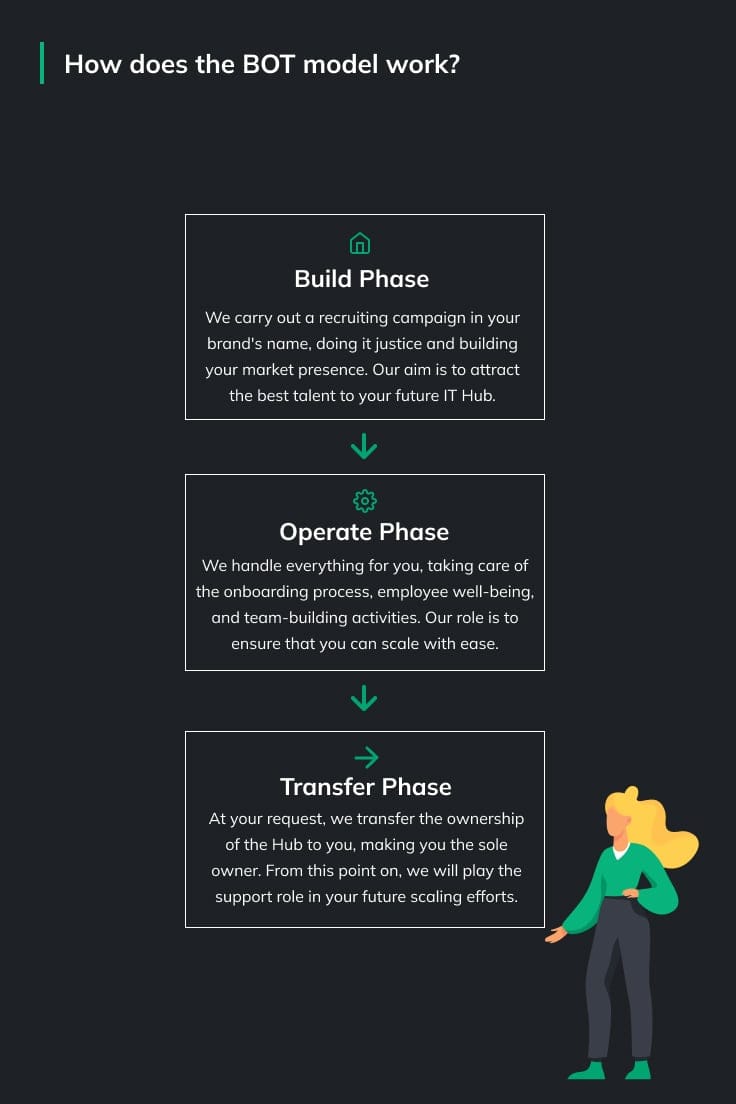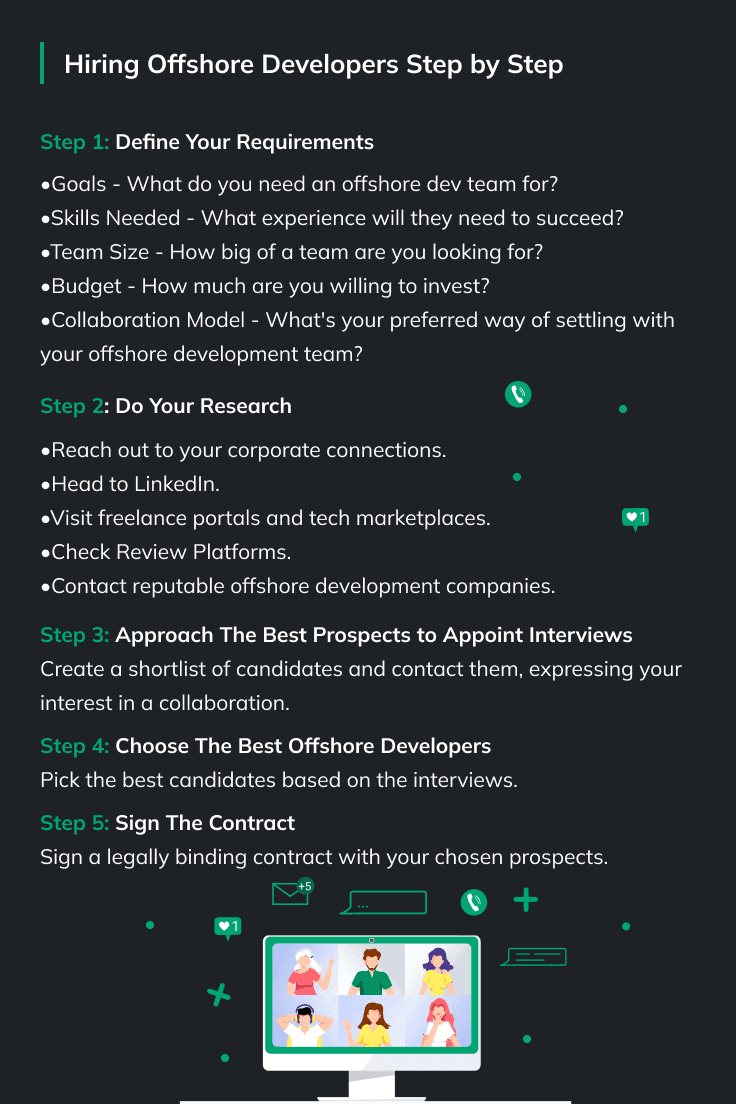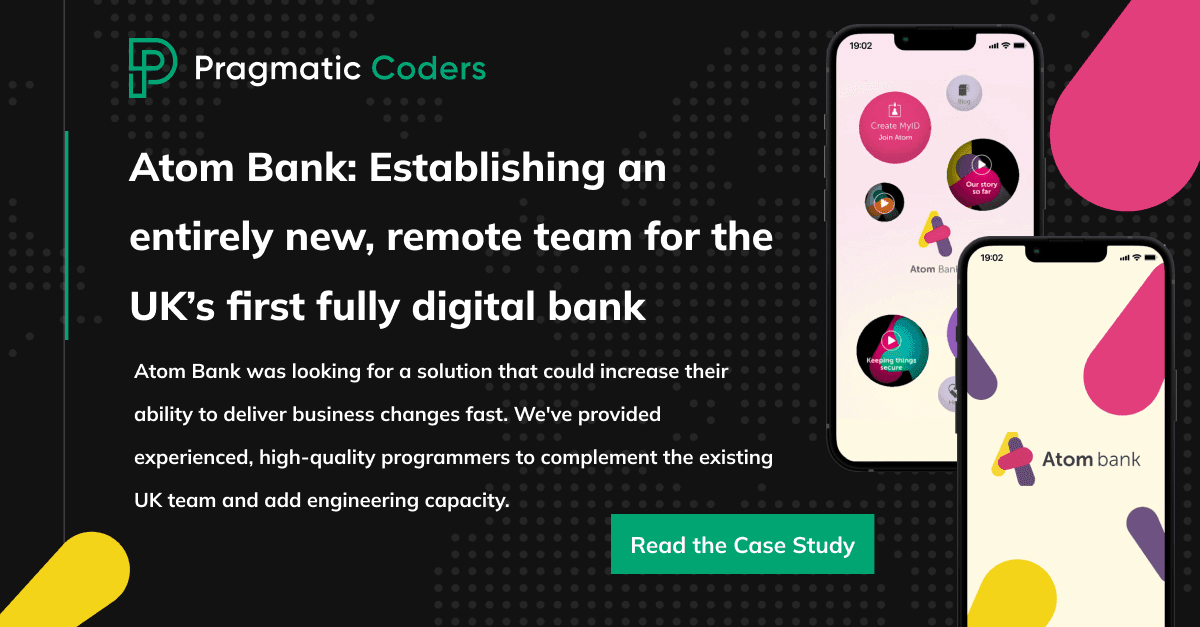How to Hire Dedicated Offshore Software Developers

Despite significant headwinds in recent years, such as the global recession affecting company budgets and leading to project cuts, 2024 presents a cautiously optimistic outlook compared to the previous year. In this cost-conscious environment, where maximizing value is paramount, offshore software development emerges as a compelling option to minimize expenses while preserving quality. By working with offshore developers, you can stretch your budget further and achieve greater value. This guide delves into the “how to” of making it work for you.
The Basics — What is offshoring, and when to hire offshore developers?
In short, offshoring software development involves hiring a team from a different country. This practice offers flexibility to outsource software-related tasks to a global talent pool. It’s a popular choice among IT startups looking for cost-efficient, skilled developers.
While working with an offshore development partner may present challenges, the benefits often outweigh the drawbacks. So, when should you hire an offshore team of software engineers?
There’s a local talent drought
As your company grows dynamically, the local pool of developers for hire might begin to seem too limited. There may come a time when hiring more devs to your in-house team simply becomes too costly and time-consuming. Expanding your hiring globally can help you navigate this challenge.
You’re being chased by tight deadlines
Relying on the development services of an internal team limits your options. Offshore software teams offer a higher flexibility and scalability for the product development process. This allows you to easily speed up the development process to meet tight deadlines.
You’re facing complex projects
Having access to a vast talent pool lets you source talented developers. With them, taking on complex and difficult projects becomes easier and much quicker.
You’re looking for dedicated experts
When you have access to a global talent base, you can cherry-pick top-notch industry specialists for your development projects.
The Benefits — why hire offshore software developers…?
There are multiple reasons for hiring an offshore development team. Not only financial but also practical and operational. Some of the biggest benefits of hiring offshore developers include:
High cost-effectiveness
For the cost of one US-based programmer, you can hire three dedicated developers in Central Europe. This is possible due to lower cost of living, average wages, and operational expenses in the region.
High productivity
With three devs, productivity more than triples compared to having just one. And that’s without an increase in development costs.
High flexibility
You hire dedicated offshore development teams based on your current needs, instead of maintaining local programmers. Thus, you avoid risky long-term commitments.
Easy scalability
Having a flexible dev structure allows you to scale your efforts up and down. This makes your company much more adaptable. You can easily hire a new team of developers if the need arises.
A vast and experienced talent pool
There are around 27.7 million software devs in the world. Chances are, some of them have already worked on projects similar to yours. By offshoring your software development, you can tap into this experience.
For a detailed comparison of nearshore and offshore software development models, including benefits, challenges, and best practices, explore our comprehensive guide on nearshore vs offshore software development outsourcing.
The Challenges — what are the common offshoring pitfalls?
While the above-mentioned benefits are undisputable, it’s worth remembering that there are also some hurdles. The biggest challenges of hiring offshore developers are:
Time zone difference
Depending on your offshore destination, your in-house and offshore employees might have limited working hours overlap. It’s up to you to ensure that there’s enough overlap to enable effective collaboration.
As a general rule, managing a time difference of 8 hours or less is feasible.
Lack of face-to-face communication
This is a common problem in any remote working environment. However, there are ways around it. Besides, recent years have made us accustomed to it.
To alleviate this, you can simply organize regular video conferences with your remote development team. Additionally, you could invest some of the funds you saved with offshoring and fly to your remote team’s location to meet them and get to know them better.
Cultural differences
Every country has its own culture. Because of this, you should expect your offshore development teams to work and communicate a bit differently than what you’re used to.
If your company is based in the US or in Western Europe, you can work around this by hiring offshore software developers from Central Europe. Doing so will ensure fewer cultural differences. To minimize misunderstandings, it’s advisable to consider hiring offshore developers with a cultural background similar to that of your country.
Finding the right team
This is, by far, the biggest challenge associated with offshoring. However, it’s not that different from finding the right local team.
You will find a detailed step-by-step guide on how to hire dedicated offshore developers later in this article.
The Destinations — where to find offshore developers for your business?
The most popular destinations for hiring offshore software developers are South America, Asia, and Eastern/Central Europe. They all offer different benefits and challenges:
South America
If your company is based in the US, you might find this option very appealing because of the time zone similarity. Choosing SA as your destination is also very cost-effective.
Offshoring leaders from this region are Brazil (over 400 thousand devs) and Mexico (close to 200 thousand devs).
Asia
This region seems to offer the widest range of offshoring services. At least, Asian IT professionals are the most eager to take on any type of assignment. Outsourcing your software development to Asia may be even more cost-effective than offshoring it to South America. The main downsides of this region include the problematic time zone difference and culture.
When it comes to the number of available devs, India is the real powerhouse here with close to 3 million of them.
Eastern/Central Europe
This region has the best all-around package. Offshoring to Eastern/Central Europe is cost-effective and gives you access to top talent. This region has a culture similar to the US and Western Europe, and the time zone is manageable. The costs here are a bit higher than in Asia or South America. However, the quality of what you get in return more than makes up for it. If you’re after high-quality software development services, choose this region.
Poland is the local offshoring leader, with close to 300 thousand professional software developers.
The Examples — what are the successful offshoring ventures?
Not convinced that offshoring is the way to go yet? Here are some success stories to change your mind.
Atom Bank
Atom Bank is the UK’s first fully digital bank. However, it faced a shortage of hi-tech specialists in the domestic market. This, combined with Brexit, threatened to hinder Atom Bank’s dynamic growth.
To address this, Atom Bank reached out to Pragmatic Coders with the task of assembling a new team of offshore developers, counting 30 specialists, within a year.
The outcome? — A streamlined app development and a significantly increased number of features and releases of Atom’s mobile application in the following years, and ongoing international cooperation.
Prequin
Prequin is a London-based investment data company. In 2019, Prequin recognized that they had to expand their engineering capacity. Otherwise, they would not be able to deliver their planned projects successfully. In short, they faced the same problem as Atom Bank did.
To alleviate the problem, Prequin started a cooperation with an offshoring company. This partnership aimed to create a small offshore development team that could be expanded if the need arose.
The outcome? — Prequin was so satisfied with the offshore team’s performance that they scaled it to 50 engineers.
AirAsia
AirAsia is a Malaysian multinational low-cost airline. In 2018, the company pursued the transformation of its loyalty program. The aim was to turn it into a true lifestyle and travel business. They needed an intuitive and universal product that would fit the needs of their customers.
To meet their goal, AirAsia chose an offshoring partner to create a well-branded website with a simple registration process. The partner also provided a modern Loyalty Management System.
The outcome? — A successful loyalty program that led AirAsia to launch multiple different cooperations in the SEA region.
The Process — how to start hiring offshore software developers?
Here are five essential steps you should follow when kickstarting your offshore software development team. Following this detailed hiring process will help you find developers with the best credentials.
Step 1: define your requirements
To find the best talent, you have to know exactly who you’re looking for. Here are some things you should consider before hiring offshore software developers. Defining them should help you hire a perfect offshore development team.
•Goals – What do you need an offshore dev team for?
•Skills Needed – What experience will they need to succeed?
•Team Size – How big of a team are you looking for?
•Budget – How much are you willing to invest?
•Collaboration Model – What’s your preferred way of settling with your offshore development team?
After writing down all your requirements, prepare a detailed job description. Make sure that it’s attention-grabbing!
Step 2: do your research
Now it’s time to ask around and search for potential offshore partners. You can do this in a few ways:
•Reach out to your corporate connections. Chances are, many companies from your sector have experience with offshoring.
•Head to LinkedIn. The site offers a great search feature with multiple filters. It will definitely help you find the specialists you’re looking for.
•Visit freelance portals and tech marketplaces. Skilled devs are actively looking for collaborations as well.
•Check Review Platforms. This is where companies share their experiences. Positive reviews will point you toward the best prospects.
•Contact reputable offshore development companies. Why not outsource your offshoring to a trusted partner?
What you’re looking for is a flexible and cost-effective offshore development team with a proven track record.
Step 3: approach the best prospects to appoint interviews
With your research done, it’s time to create a shortlist of candidates. Make sure they meet, or better yet, exceed all your requirements.
With that done, contact them and express your interest in a collaboration. It’s time for some HR work. Make it a point to learn about the candidates’ work culture, past experiences, and expertise during the interviews.
Step 4: choose the best offshore developers
After the interviews are over, refer to your notes and pick the best candidates. Make sure everything about them is aligned with your requirements!
Step 5: sign the contract
It’s finally time to kick off the collaboration. Sign a legally binding contract with your chosen prospects. Not sure what to include? Don’t worry, you can just use this free Build Operate Transfer Contract Template!
At this point, you should also discuss with your new partner what project management tool would be optimal for your mutual needs.
Pragmatic Coders — your future offshore software development team?
At Pragmatic Coders, we know how to create nearshore and offshore software development centers.
Looking for a product development partner? We’ve got you covered. Need a group of engineers? We can help. Want to establish your IT department in Poland? Trust us, we’ve got your back!
What Makes Pragmatic Coders’ offshoring offer stand out?
Full transparency
Right from the start, you’ll be informed of the salary of each and every employee, along with our profit margin.
Professional representation of your brand
We know how to do your brand justice in the local employment market. And we know exactly how to promote it.
Proven engagement model
We use the Build-Operate-Transfer model, which allows us to attract and acquire the best prospects.

Employee transfer
Every specialist hired through Pragmatic Coders knows they can join the client directly. We test the waters for the first three months to ensure a good fit. After that period, any team member can transfer to you.
What is the Build-Operate-Transfer (BOT) model in offshoring?
The Build-Operate-Transfer model is a strategic outsourcing approach where a client company partners with an external service provider to establish and manage a dedicated software development team. Here’s how it works:
- Build: The service provider takes on the responsibility of recruiting, onboarding, and establishing the infrastructure for a new software development team. This team is tailored to the client company’s specific needs and technological requirements.
- Operate: During this phase, the service provider manages the entire team’s operation. This includes project management, software development processes, quality assurance, and the overall smooth running of development activities. The client focuses on defining the software product roadmap and providing guidance.
- Transfer: Once the team is mature, stable, and aligns with the client company’s work processes and culture, a full ownership transfer takes place. The client acquires the entire team, infrastructure, and intellectual property.
Benefits of BOT for software development outsourcing
- Reduced Risk: The service provider bears the initial risks of setting up the team and establishing it within the outsourcing location.
- Cost-Effectiveness: BOT often proves more cost-effective than building an in-house team from scratch, especially when accessing talent pools in regions with lower development costs.
- Focus on Core Business: The client company can concentrate on core business activities while the service provider takes care of establishing and running the software development center.
- Access to Expertise: BOT gives companies access to the service provider’s expertise in talent acquisition, team management, and best practices in software development methodology.
- Scalability: BOT offers the flexibility to easily scale the team up or down as needed.
When is the BOT model a good fit?
BOT is ideal for companies when:
- They need a dedicated team for long-term software development projects
- They want to establish a development hub in a different country to tap into a specific talent pool
- They lack the internal resources or expertise to set up and manage a team on their own
- They want to reduce the risks and costs associated with team setup
Key considerations when using BOT
- Choosing the Right Partner: Select a service provider with a proven track record and deep understanding of your business domain and technology.
- Governance Model: Establish a clear governance model defining roles, responsibilities, and decision-making processes.
- Cultural Integration: Plan how to integrate the offshore team into your company culture to maximize collaboration.
- Knowledge Transfer: Ensure processes are in place for the smooth transfer of project knowledge and intellectual property during the transfer phase.
The offshoring FAQ — still looking for answers?
Have more questions? Send them to us and we’ll add the answers down below.
How much does a dedicated offshore developer cost?
A dedicated offshore developer can cost anywhere between $25-$100 per hour. Here are the average hourly rates for the most popular offshoring destinations:
•Eastern Europe: $55-$95
•South America: $60-$100
•Asia (India Philippines): $50-$70
You can also check this comprehensive guide to the costs of offshoring software development.
How do I hire developers for my offshore development team?
Here are five proven steps you should take to hire the best offshore developers:
•Step 1: Define Your Requirements
•Step 2: Do Your Research
•Step 3: Approach The Best Prospects to Appoint Interviews
•Step 4: Choose The Best Prospects
•Step 5: Sign The Contract
How do I hire offshore developers for a startup?
If you’re looking for a single developer, Freelancing Platforms are your best bet. The most popular of them are Upwork, Fiverr, Arc, and Toptal. If you’re looking for multiple remote developers, our outsourcing guide can help you.
Where to find an offshore development team?
There are multiple places where you can look for one:
•LinkedIn – specialists from around the world look for contracts there
•Freelance Portals and Tech Marketplaces – developers regularly advertise on such portals
•Review Platforms – contact devs with multiple positive reviews
•Offshore Software Development Companies – firms, such as NxTide can help you build your offshore development team
What are the benefits of hiring an offshore development company?
•High Cost-Effectiveness – average salary rates in Central and Eastern Europe are visibly lower than in the US or Western Europe
•High Productivity – you can hire more devs for the same price
•High Flexibility – you can avoid long-term commitments with a task-based approach to contracts
•Easy Scalability – you can scale your offshore development team up and down, depending on your needs
•Access to a Vast and Experienced Talent Pool – there are literally tens of millions of software developers in the world
Conclusions
In today’s harsh business environment, offshoring software development can make your company thrive. With it, you gain great scalability and flexibility. You save costs while increasing development speed. And you tap into the best international talent out there.
If you’re seeking a trusted offshoring partner, please contact us via this form. Let’s discuss your specific needs and goals. We look forward to collaborating with you! Together, we will build a world-class offshore development team.






